Electric Mobility Scooters: A Sustainability Management Report
VerifiedAdded on 2021/05/31
|16
|3742
|25
Report
AI Summary
This research paper investigates the sustainability management of electric mobility scooter manufacturing, focusing on applying the circular economy concept to current linear energy and material flows. The report analyzes the major components, including structural, electrical, and miscellaneous parts, and discusses the importance of chassis, suspension, batteries, and bodywork design. It explores future industrial system sustainability, emphasizing principles like territorial and industrial ecology, eco-design, renewable energy sources, functionality economy, valorization, and recycling. The paper highlights the need for companies to adopt circular economy practices to minimize environmental impact and promote resource efficiency through reuse, recycling, and reduction of waste. The study emphasizes the benefits of a circular model for environmental, social, and economic sustainability, encouraging a shift from linear models to a more sustainable approach.
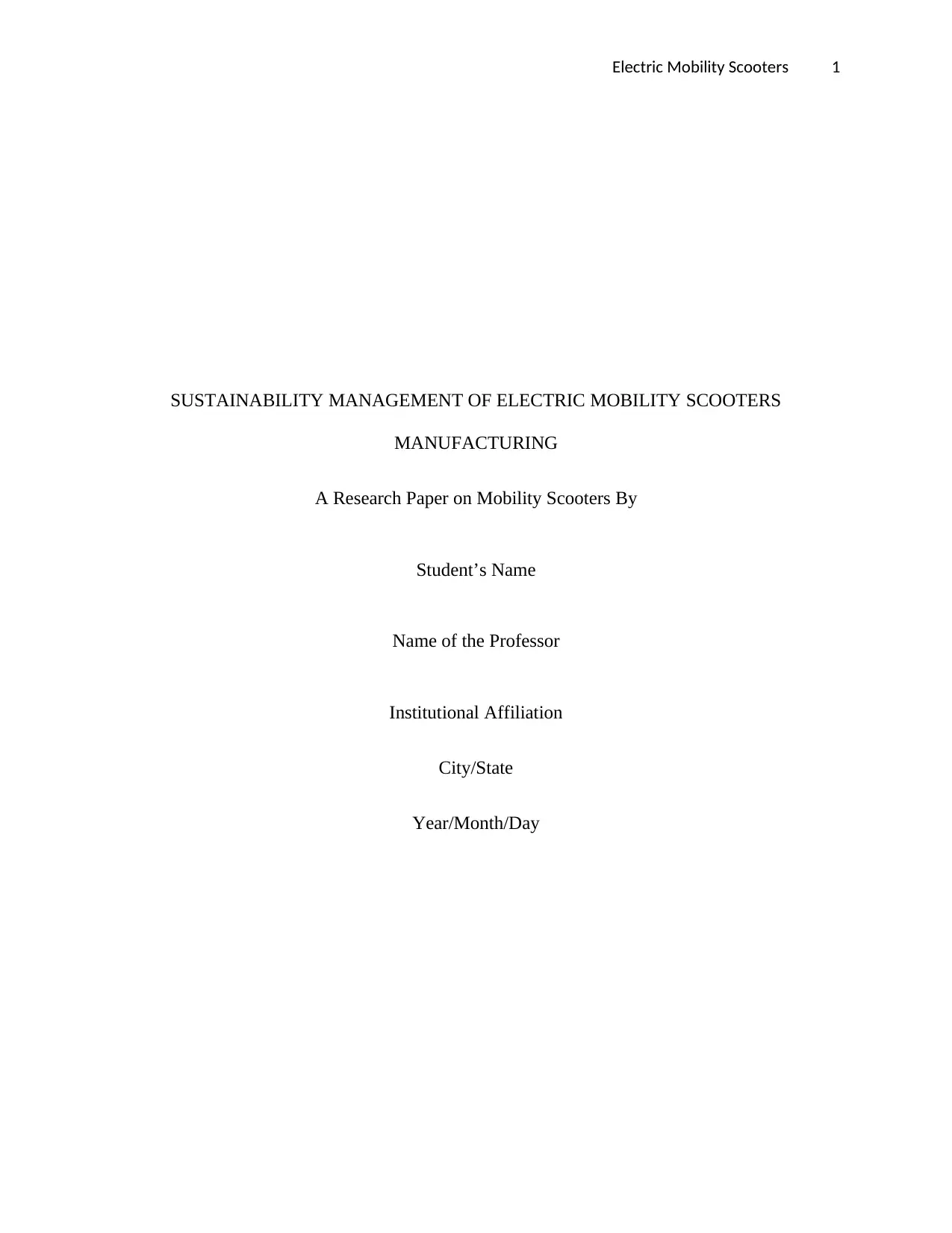
Electric Mobility Scooters 1
SUSTAINABILITY MANAGEMENT OF ELECTRIC MOBILITY SCOOTERS
MANUFACTURING
A Research Paper on Mobility Scooters By
Student’s Name
Name of the Professor
Institutional Affiliation
City/State
Year/Month/Day
SUSTAINABILITY MANAGEMENT OF ELECTRIC MOBILITY SCOOTERS
MANUFACTURING
A Research Paper on Mobility Scooters By
Student’s Name
Name of the Professor
Institutional Affiliation
City/State
Year/Month/Day
Paraphrase This Document
Need a fresh take? Get an instant paraphrase of this document with our AI Paraphraser
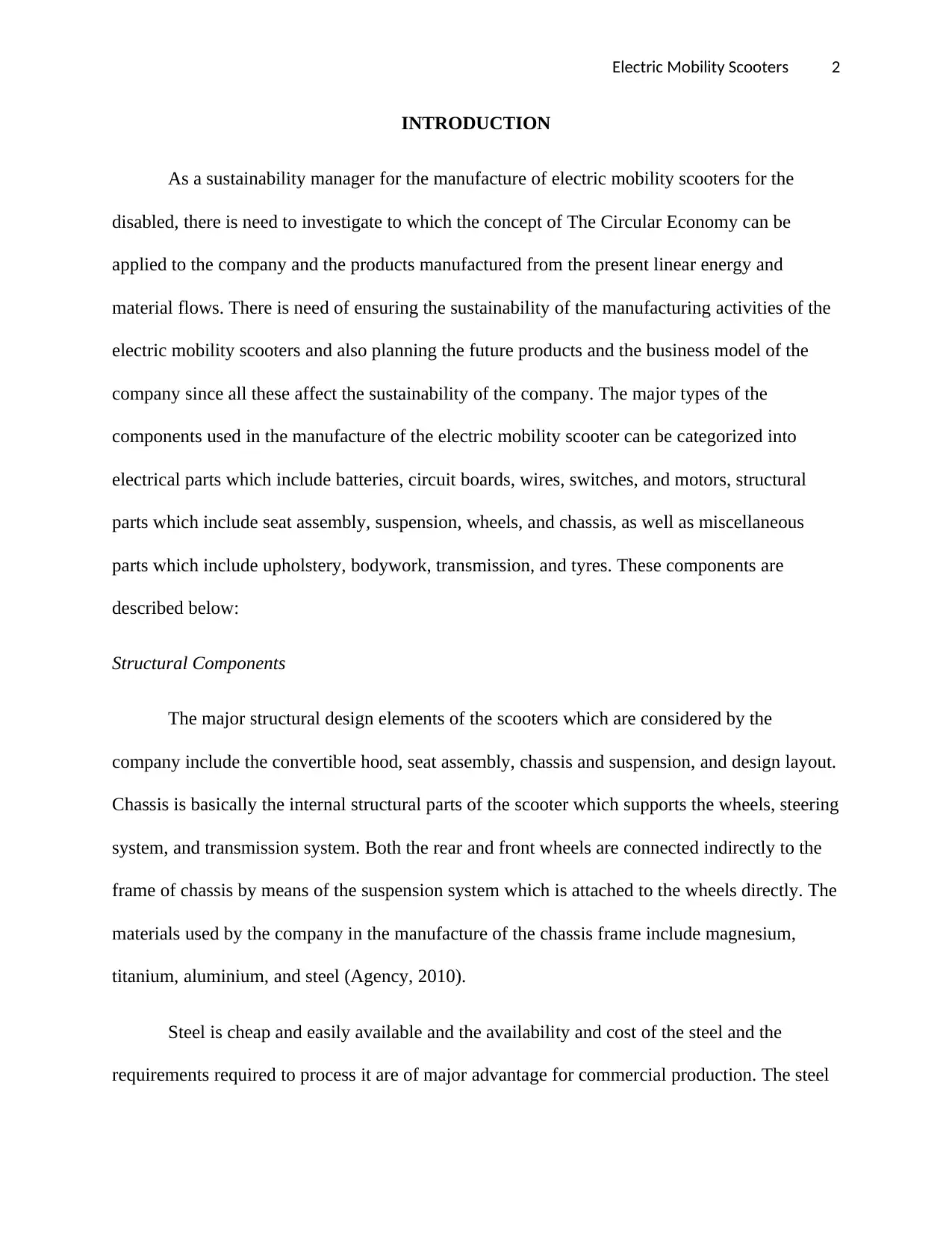
Electric Mobility Scooters 2
INTRODUCTION
As a sustainability manager for the manufacture of electric mobility scooters for the
disabled, there is need to investigate to which the concept of The Circular Economy can be
applied to the company and the products manufactured from the present linear energy and
material flows. There is need of ensuring the sustainability of the manufacturing activities of the
electric mobility scooters and also planning the future products and the business model of the
company since all these affect the sustainability of the company. The major types of the
components used in the manufacture of the electric mobility scooter can be categorized into
electrical parts which include batteries, circuit boards, wires, switches, and motors, structural
parts which include seat assembly, suspension, wheels, and chassis, as well as miscellaneous
parts which include upholstery, bodywork, transmission, and tyres. These components are
described below:
Structural Components
The major structural design elements of the scooters which are considered by the
company include the convertible hood, seat assembly, chassis and suspension, and design layout.
Chassis is basically the internal structural parts of the scooter which supports the wheels, steering
system, and transmission system. Both the rear and front wheels are connected indirectly to the
frame of chassis by means of the suspension system which is attached to the wheels directly. The
materials used by the company in the manufacture of the chassis frame include magnesium,
titanium, aluminium, and steel (Agency, 2010).
Steel is cheap and easily available and the availability and cost of the steel and the
requirements required to process it are of major advantage for commercial production. The steel
INTRODUCTION
As a sustainability manager for the manufacture of electric mobility scooters for the
disabled, there is need to investigate to which the concept of The Circular Economy can be
applied to the company and the products manufactured from the present linear energy and
material flows. There is need of ensuring the sustainability of the manufacturing activities of the
electric mobility scooters and also planning the future products and the business model of the
company since all these affect the sustainability of the company. The major types of the
components used in the manufacture of the electric mobility scooter can be categorized into
electrical parts which include batteries, circuit boards, wires, switches, and motors, structural
parts which include seat assembly, suspension, wheels, and chassis, as well as miscellaneous
parts which include upholstery, bodywork, transmission, and tyres. These components are
described below:
Structural Components
The major structural design elements of the scooters which are considered by the
company include the convertible hood, seat assembly, chassis and suspension, and design layout.
Chassis is basically the internal structural parts of the scooter which supports the wheels, steering
system, and transmission system. Both the rear and front wheels are connected indirectly to the
frame of chassis by means of the suspension system which is attached to the wheels directly. The
materials used by the company in the manufacture of the chassis frame include magnesium,
titanium, aluminium, and steel (Agency, 2010).
Steel is cheap and easily available and the availability and cost of the steel and the
requirements required to process it are of major advantage for commercial production. The steel
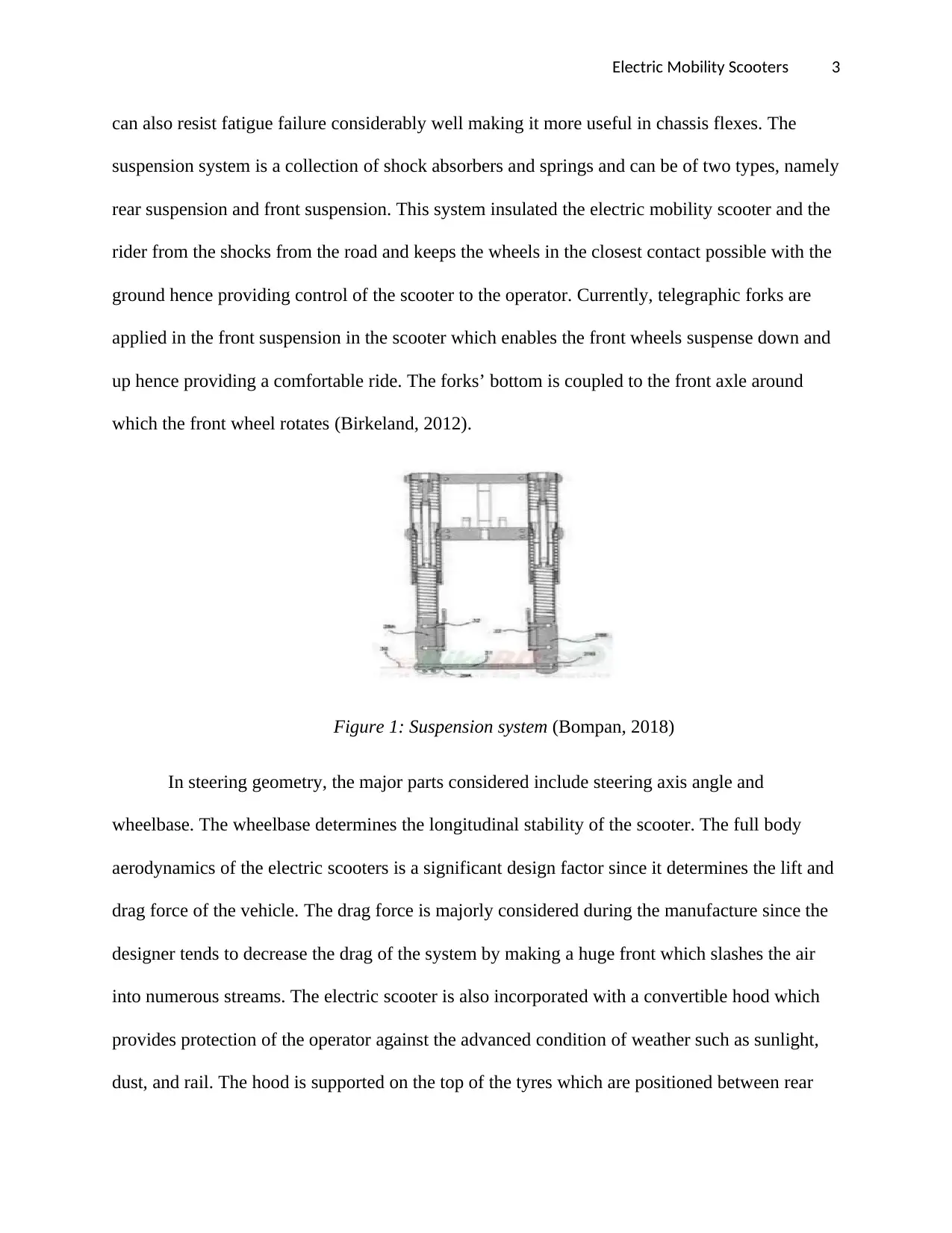
Electric Mobility Scooters 3
can also resist fatigue failure considerably well making it more useful in chassis flexes. The
suspension system is a collection of shock absorbers and springs and can be of two types, namely
rear suspension and front suspension. This system insulated the electric mobility scooter and the
rider from the shocks from the road and keeps the wheels in the closest contact possible with the
ground hence providing control of the scooter to the operator. Currently, telegraphic forks are
applied in the front suspension in the scooter which enables the front wheels suspense down and
up hence providing a comfortable ride. The forks’ bottom is coupled to the front axle around
which the front wheel rotates (Birkeland, 2012).
Figure 1: Suspension system (Bompan, 2018)
In steering geometry, the major parts considered include steering axis angle and
wheelbase. The wheelbase determines the longitudinal stability of the scooter. The full body
aerodynamics of the electric scooters is a significant design factor since it determines the lift and
drag force of the vehicle. The drag force is majorly considered during the manufacture since the
designer tends to decrease the drag of the system by making a huge front which slashes the air
into numerous streams. The electric scooter is also incorporated with a convertible hood which
provides protection of the operator against the advanced condition of weather such as sunlight,
dust, and rail. The hood is supported on the top of the tyres which are positioned between rear
can also resist fatigue failure considerably well making it more useful in chassis flexes. The
suspension system is a collection of shock absorbers and springs and can be of two types, namely
rear suspension and front suspension. This system insulated the electric mobility scooter and the
rider from the shocks from the road and keeps the wheels in the closest contact possible with the
ground hence providing control of the scooter to the operator. Currently, telegraphic forks are
applied in the front suspension in the scooter which enables the front wheels suspense down and
up hence providing a comfortable ride. The forks’ bottom is coupled to the front axle around
which the front wheel rotates (Birkeland, 2012).
Figure 1: Suspension system (Bompan, 2018)
In steering geometry, the major parts considered include steering axis angle and
wheelbase. The wheelbase determines the longitudinal stability of the scooter. The full body
aerodynamics of the electric scooters is a significant design factor since it determines the lift and
drag force of the vehicle. The drag force is majorly considered during the manufacture since the
designer tends to decrease the drag of the system by making a huge front which slashes the air
into numerous streams. The electric scooter is also incorporated with a convertible hood which
provides protection of the operator against the advanced condition of weather such as sunlight,
dust, and rail. The hood is supported on the top of the tyres which are positioned between rear
⊘ This is a preview!⊘
Do you want full access?
Subscribe today to unlock all pages.

Trusted by 1+ million students worldwide
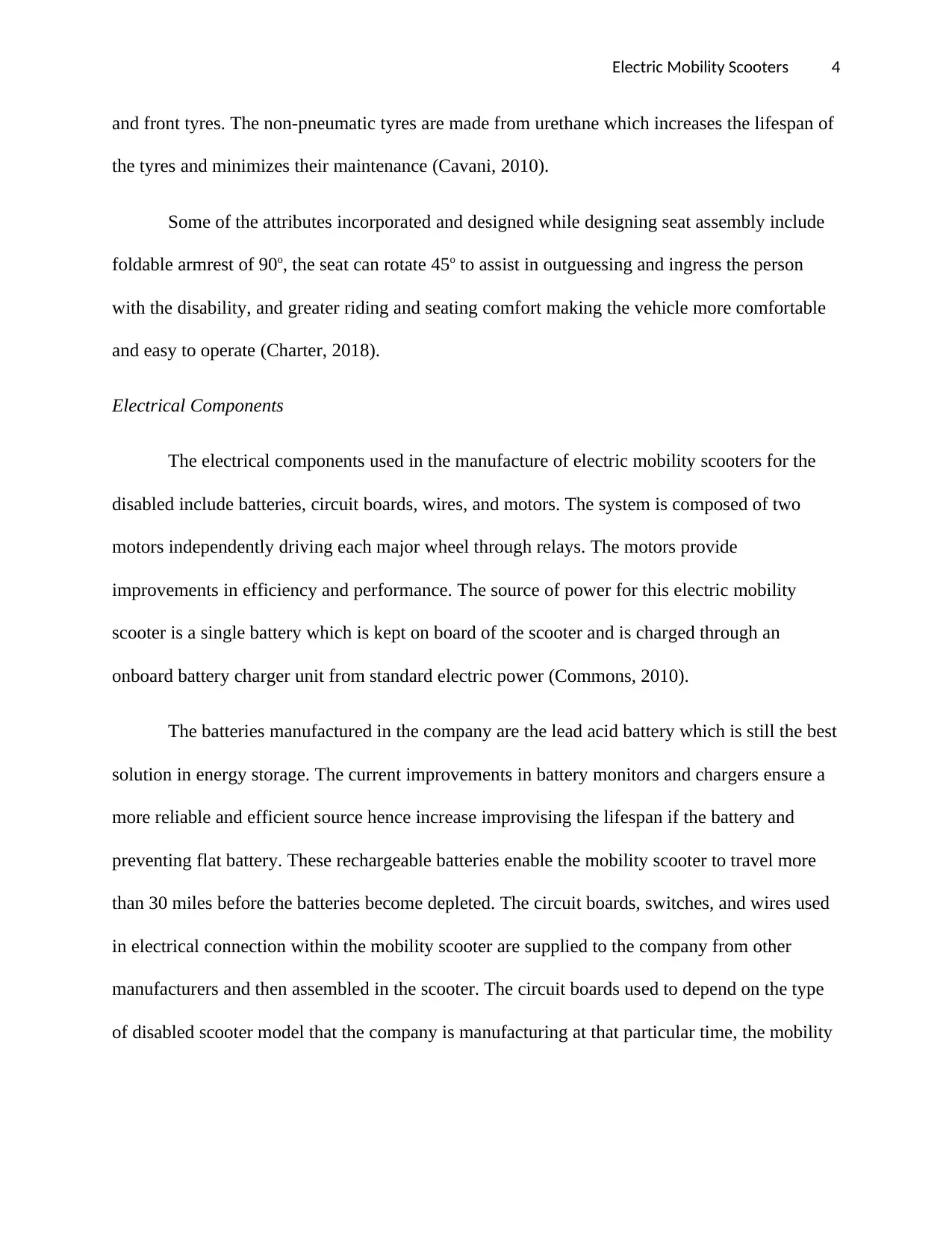
Electric Mobility Scooters 4
and front tyres. The non-pneumatic tyres are made from urethane which increases the lifespan of
the tyres and minimizes their maintenance (Cavani, 2010).
Some of the attributes incorporated and designed while designing seat assembly include
foldable armrest of 90o, the seat can rotate 45o to assist in outguessing and ingress the person
with the disability, and greater riding and seating comfort making the vehicle more comfortable
and easy to operate (Charter, 2018).
Electrical Components
The electrical components used in the manufacture of electric mobility scooters for the
disabled include batteries, circuit boards, wires, and motors. The system is composed of two
motors independently driving each major wheel through relays. The motors provide
improvements in efficiency and performance. The source of power for this electric mobility
scooter is a single battery which is kept on board of the scooter and is charged through an
onboard battery charger unit from standard electric power (Commons, 2010).
The batteries manufactured in the company are the lead acid battery which is still the best
solution in energy storage. The current improvements in battery monitors and chargers ensure a
more reliable and efficient source hence increase improvising the lifespan if the battery and
preventing flat battery. These rechargeable batteries enable the mobility scooter to travel more
than 30 miles before the batteries become depleted. The circuit boards, switches, and wires used
in electrical connection within the mobility scooter are supplied to the company from other
manufacturers and then assembled in the scooter. The circuit boards used to depend on the type
of disabled scooter model that the company is manufacturing at that particular time, the mobility
and front tyres. The non-pneumatic tyres are made from urethane which increases the lifespan of
the tyres and minimizes their maintenance (Cavani, 2010).
Some of the attributes incorporated and designed while designing seat assembly include
foldable armrest of 90o, the seat can rotate 45o to assist in outguessing and ingress the person
with the disability, and greater riding and seating comfort making the vehicle more comfortable
and easy to operate (Charter, 2018).
Electrical Components
The electrical components used in the manufacture of electric mobility scooters for the
disabled include batteries, circuit boards, wires, and motors. The system is composed of two
motors independently driving each major wheel through relays. The motors provide
improvements in efficiency and performance. The source of power for this electric mobility
scooter is a single battery which is kept on board of the scooter and is charged through an
onboard battery charger unit from standard electric power (Commons, 2010).
The batteries manufactured in the company are the lead acid battery which is still the best
solution in energy storage. The current improvements in battery monitors and chargers ensure a
more reliable and efficient source hence increase improvising the lifespan if the battery and
preventing flat battery. These rechargeable batteries enable the mobility scooter to travel more
than 30 miles before the batteries become depleted. The circuit boards, switches, and wires used
in electrical connection within the mobility scooter are supplied to the company from other
manufacturers and then assembled in the scooter. The circuit boards used to depend on the type
of disabled scooter model that the company is manufacturing at that particular time, the mobility
Paraphrase This Document
Need a fresh take? Get an instant paraphrase of this document with our AI Paraphraser
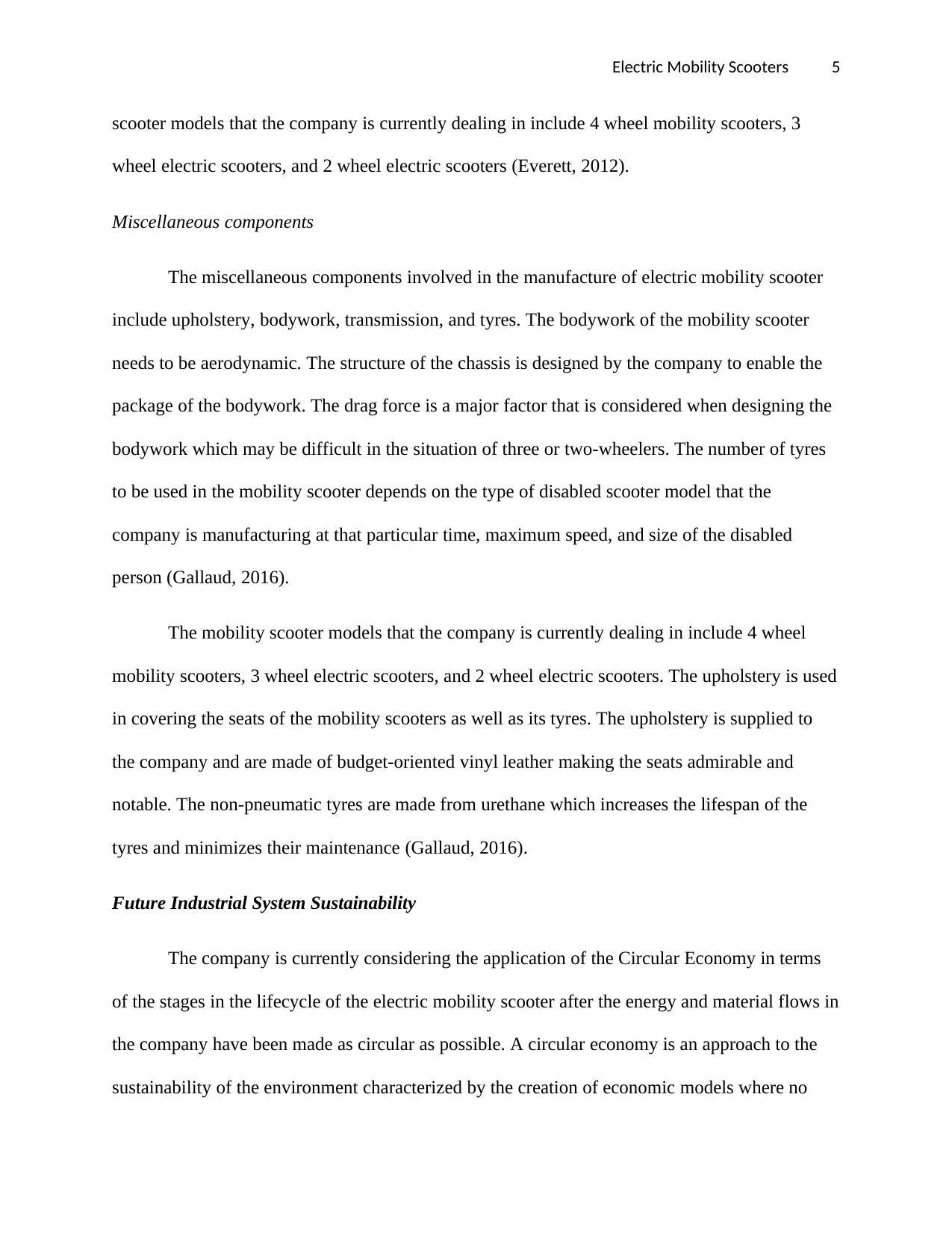
Electric Mobility Scooters 5
scooter models that the company is currently dealing in include 4 wheel mobility scooters, 3
wheel electric scooters, and 2 wheel electric scooters (Everett, 2012).
Miscellaneous components
The miscellaneous components involved in the manufacture of electric mobility scooter
include upholstery, bodywork, transmission, and tyres. The bodywork of the mobility scooter
needs to be aerodynamic. The structure of the chassis is designed by the company to enable the
package of the bodywork. The drag force is a major factor that is considered when designing the
bodywork which may be difficult in the situation of three or two-wheelers. The number of tyres
to be used in the mobility scooter depends on the type of disabled scooter model that the
company is manufacturing at that particular time, maximum speed, and size of the disabled
person (Gallaud, 2016).
The mobility scooter models that the company is currently dealing in include 4 wheel
mobility scooters, 3 wheel electric scooters, and 2 wheel electric scooters. The upholstery is used
in covering the seats of the mobility scooters as well as its tyres. The upholstery is supplied to
the company and are made of budget-oriented vinyl leather making the seats admirable and
notable. The non-pneumatic tyres are made from urethane which increases the lifespan of the
tyres and minimizes their maintenance (Gallaud, 2016).
Future Industrial System Sustainability
The company is currently considering the application of the Circular Economy in terms
of the stages in the lifecycle of the electric mobility scooter after the energy and material flows in
the company have been made as circular as possible. A circular economy is an approach to the
sustainability of the environment characterized by the creation of economic models where no
scooter models that the company is currently dealing in include 4 wheel mobility scooters, 3
wheel electric scooters, and 2 wheel electric scooters (Everett, 2012).
Miscellaneous components
The miscellaneous components involved in the manufacture of electric mobility scooter
include upholstery, bodywork, transmission, and tyres. The bodywork of the mobility scooter
needs to be aerodynamic. The structure of the chassis is designed by the company to enable the
package of the bodywork. The drag force is a major factor that is considered when designing the
bodywork which may be difficult in the situation of three or two-wheelers. The number of tyres
to be used in the mobility scooter depends on the type of disabled scooter model that the
company is manufacturing at that particular time, maximum speed, and size of the disabled
person (Gallaud, 2016).
The mobility scooter models that the company is currently dealing in include 4 wheel
mobility scooters, 3 wheel electric scooters, and 2 wheel electric scooters. The upholstery is used
in covering the seats of the mobility scooters as well as its tyres. The upholstery is supplied to
the company and are made of budget-oriented vinyl leather making the seats admirable and
notable. The non-pneumatic tyres are made from urethane which increases the lifespan of the
tyres and minimizes their maintenance (Gallaud, 2016).
Future Industrial System Sustainability
The company is currently considering the application of the Circular Economy in terms
of the stages in the lifecycle of the electric mobility scooter after the energy and material flows in
the company have been made as circular as possible. A circular economy is an approach to the
sustainability of the environment characterized by the creation of economic models where no
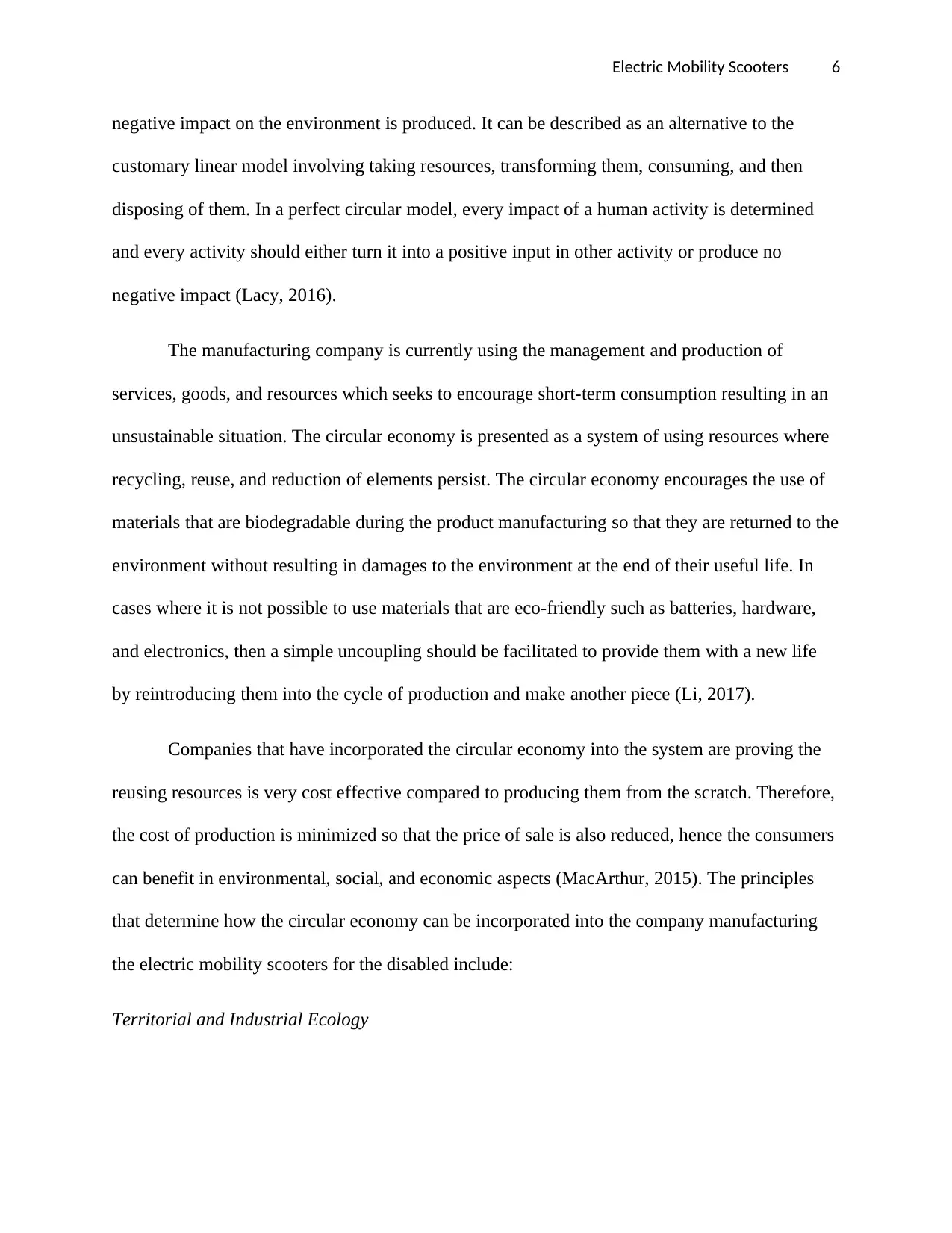
Electric Mobility Scooters 6
negative impact on the environment is produced. It can be described as an alternative to the
customary linear model involving taking resources, transforming them, consuming, and then
disposing of them. In a perfect circular model, every impact of a human activity is determined
and every activity should either turn it into a positive input in other activity or produce no
negative impact (Lacy, 2016).
The manufacturing company is currently using the management and production of
services, goods, and resources which seeks to encourage short-term consumption resulting in an
unsustainable situation. The circular economy is presented as a system of using resources where
recycling, reuse, and reduction of elements persist. The circular economy encourages the use of
materials that are biodegradable during the product manufacturing so that they are returned to the
environment without resulting in damages to the environment at the end of their useful life. In
cases where it is not possible to use materials that are eco-friendly such as batteries, hardware,
and electronics, then a simple uncoupling should be facilitated to provide them with a new life
by reintroducing them into the cycle of production and make another piece (Li, 2017).
Companies that have incorporated the circular economy into the system are proving the
reusing resources is very cost effective compared to producing them from the scratch. Therefore,
the cost of production is minimized so that the price of sale is also reduced, hence the consumers
can benefit in environmental, social, and economic aspects (MacArthur, 2015). The principles
that determine how the circular economy can be incorporated into the company manufacturing
the electric mobility scooters for the disabled include:
Territorial and Industrial Ecology
negative impact on the environment is produced. It can be described as an alternative to the
customary linear model involving taking resources, transforming them, consuming, and then
disposing of them. In a perfect circular model, every impact of a human activity is determined
and every activity should either turn it into a positive input in other activity or produce no
negative impact (Lacy, 2016).
The manufacturing company is currently using the management and production of
services, goods, and resources which seeks to encourage short-term consumption resulting in an
unsustainable situation. The circular economy is presented as a system of using resources where
recycling, reuse, and reduction of elements persist. The circular economy encourages the use of
materials that are biodegradable during the product manufacturing so that they are returned to the
environment without resulting in damages to the environment at the end of their useful life. In
cases where it is not possible to use materials that are eco-friendly such as batteries, hardware,
and electronics, then a simple uncoupling should be facilitated to provide them with a new life
by reintroducing them into the cycle of production and make another piece (Li, 2017).
Companies that have incorporated the circular economy into the system are proving the
reusing resources is very cost effective compared to producing them from the scratch. Therefore,
the cost of production is minimized so that the price of sale is also reduced, hence the consumers
can benefit in environmental, social, and economic aspects (MacArthur, 2015). The principles
that determine how the circular economy can be incorporated into the company manufacturing
the electric mobility scooters for the disabled include:
Territorial and Industrial Ecology
⊘ This is a preview!⊘
Do you want full access?
Subscribe today to unlock all pages.

Trusted by 1+ million students worldwide
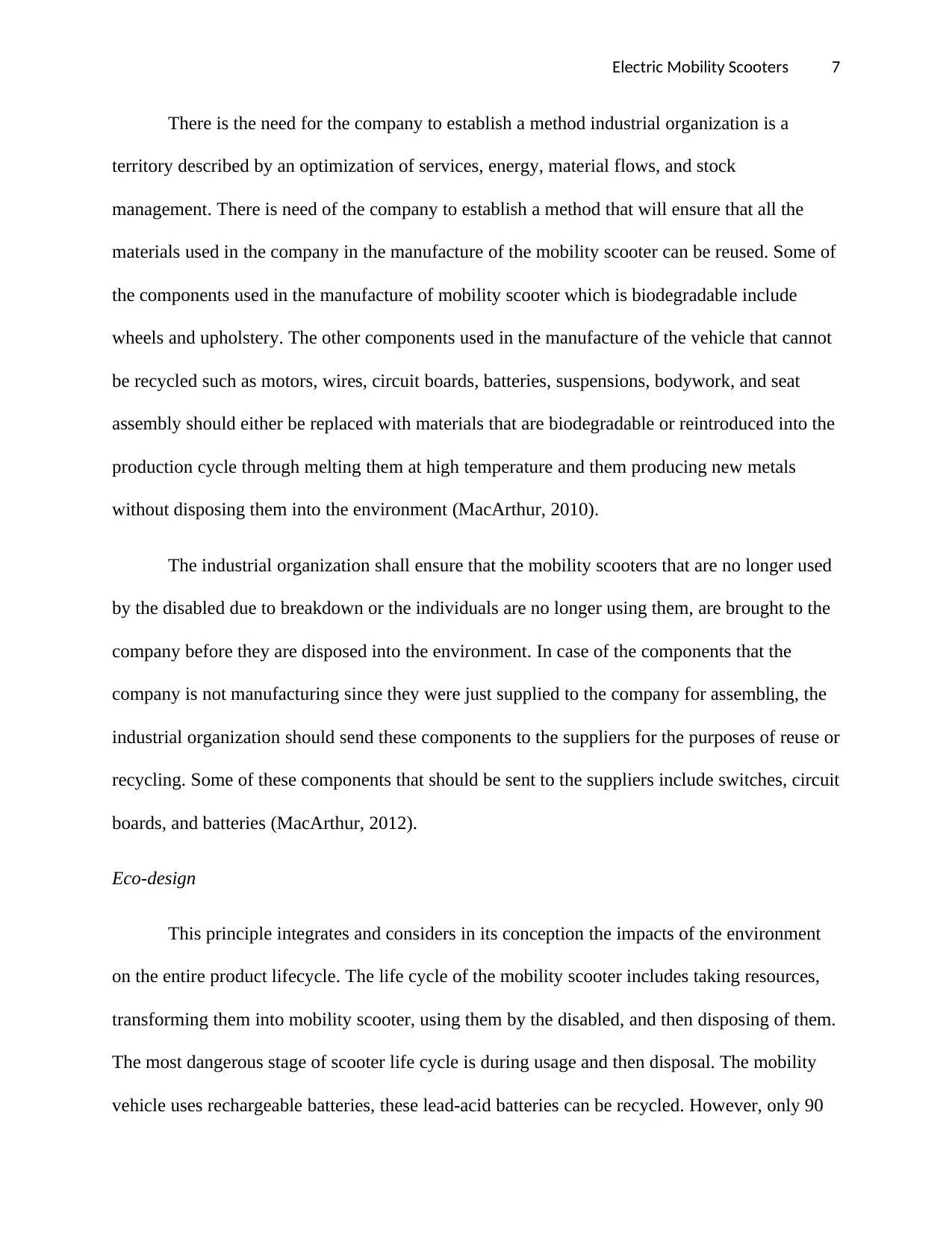
Electric Mobility Scooters 7
There is the need for the company to establish a method industrial organization is a
territory described by an optimization of services, energy, material flows, and stock
management. There is need of the company to establish a method that will ensure that all the
materials used in the company in the manufacture of the mobility scooter can be reused. Some of
the components used in the manufacture of mobility scooter which is biodegradable include
wheels and upholstery. The other components used in the manufacture of the vehicle that cannot
be recycled such as motors, wires, circuit boards, batteries, suspensions, bodywork, and seat
assembly should either be replaced with materials that are biodegradable or reintroduced into the
production cycle through melting them at high temperature and them producing new metals
without disposing them into the environment (MacArthur, 2010).
The industrial organization shall ensure that the mobility scooters that are no longer used
by the disabled due to breakdown or the individuals are no longer using them, are brought to the
company before they are disposed into the environment. In case of the components that the
company is not manufacturing since they were just supplied to the company for assembling, the
industrial organization should send these components to the suppliers for the purposes of reuse or
recycling. Some of these components that should be sent to the suppliers include switches, circuit
boards, and batteries (MacArthur, 2012).
Eco-design
This principle integrates and considers in its conception the impacts of the environment
on the entire product lifecycle. The life cycle of the mobility scooter includes taking resources,
transforming them into mobility scooter, using them by the disabled, and then disposing of them.
The most dangerous stage of scooter life cycle is during usage and then disposal. The mobility
vehicle uses rechargeable batteries, these lead-acid batteries can be recycled. However, only 90
There is the need for the company to establish a method industrial organization is a
territory described by an optimization of services, energy, material flows, and stock
management. There is need of the company to establish a method that will ensure that all the
materials used in the company in the manufacture of the mobility scooter can be reused. Some of
the components used in the manufacture of mobility scooter which is biodegradable include
wheels and upholstery. The other components used in the manufacture of the vehicle that cannot
be recycled such as motors, wires, circuit boards, batteries, suspensions, bodywork, and seat
assembly should either be replaced with materials that are biodegradable or reintroduced into the
production cycle through melting them at high temperature and them producing new metals
without disposing them into the environment (MacArthur, 2010).
The industrial organization shall ensure that the mobility scooters that are no longer used
by the disabled due to breakdown or the individuals are no longer using them, are brought to the
company before they are disposed into the environment. In case of the components that the
company is not manufacturing since they were just supplied to the company for assembling, the
industrial organization should send these components to the suppliers for the purposes of reuse or
recycling. Some of these components that should be sent to the suppliers include switches, circuit
boards, and batteries (MacArthur, 2012).
Eco-design
This principle integrates and considers in its conception the impacts of the environment
on the entire product lifecycle. The life cycle of the mobility scooter includes taking resources,
transforming them into mobility scooter, using them by the disabled, and then disposing of them.
The most dangerous stage of scooter life cycle is during usage and then disposal. The mobility
vehicle uses rechargeable batteries, these lead-acid batteries can be recycled. However, only 90
Paraphrase This Document
Need a fresh take? Get an instant paraphrase of this document with our AI Paraphraser
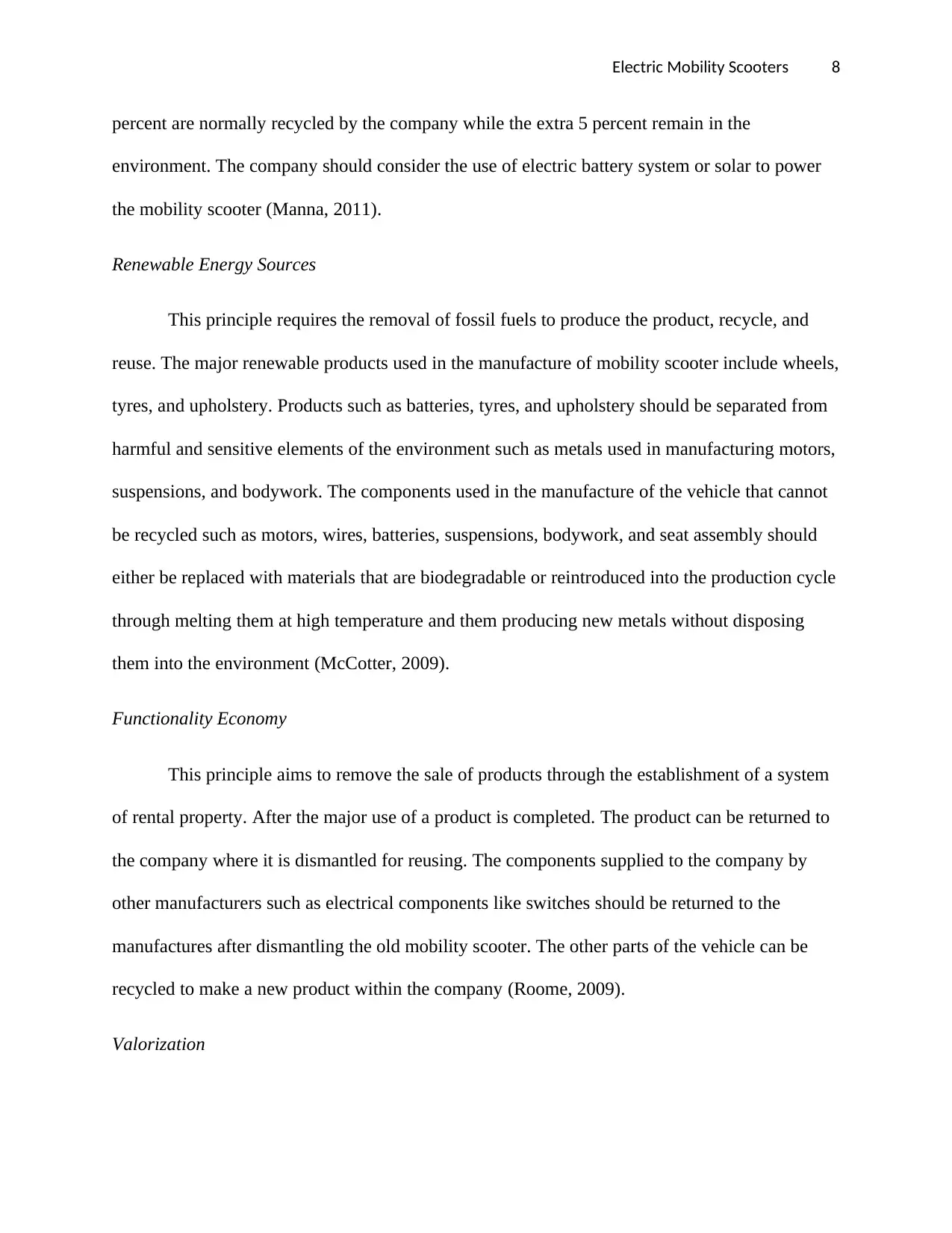
Electric Mobility Scooters 8
percent are normally recycled by the company while the extra 5 percent remain in the
environment. The company should consider the use of electric battery system or solar to power
the mobility scooter (Manna, 2011).
Renewable Energy Sources
This principle requires the removal of fossil fuels to produce the product, recycle, and
reuse. The major renewable products used in the manufacture of mobility scooter include wheels,
tyres, and upholstery. Products such as batteries, tyres, and upholstery should be separated from
harmful and sensitive elements of the environment such as metals used in manufacturing motors,
suspensions, and bodywork. The components used in the manufacture of the vehicle that cannot
be recycled such as motors, wires, batteries, suspensions, bodywork, and seat assembly should
either be replaced with materials that are biodegradable or reintroduced into the production cycle
through melting them at high temperature and them producing new metals without disposing
them into the environment (McCotter, 2009).
Functionality Economy
This principle aims to remove the sale of products through the establishment of a system
of rental property. After the major use of a product is completed. The product can be returned to
the company where it is dismantled for reusing. The components supplied to the company by
other manufacturers such as electrical components like switches should be returned to the
manufactures after dismantling the old mobility scooter. The other parts of the vehicle can be
recycled to make a new product within the company (Roome, 2009).
Valorization
percent are normally recycled by the company while the extra 5 percent remain in the
environment. The company should consider the use of electric battery system or solar to power
the mobility scooter (Manna, 2011).
Renewable Energy Sources
This principle requires the removal of fossil fuels to produce the product, recycle, and
reuse. The major renewable products used in the manufacture of mobility scooter include wheels,
tyres, and upholstery. Products such as batteries, tyres, and upholstery should be separated from
harmful and sensitive elements of the environment such as metals used in manufacturing motors,
suspensions, and bodywork. The components used in the manufacture of the vehicle that cannot
be recycled such as motors, wires, batteries, suspensions, bodywork, and seat assembly should
either be replaced with materials that are biodegradable or reintroduced into the production cycle
through melting them at high temperature and them producing new metals without disposing
them into the environment (McCotter, 2009).
Functionality Economy
This principle aims to remove the sale of products through the establishment of a system
of rental property. After the major use of a product is completed. The product can be returned to
the company where it is dismantled for reusing. The components supplied to the company by
other manufacturers such as electrical components like switches should be returned to the
manufactures after dismantling the old mobility scooter. The other parts of the vehicle can be
recycled to make a new product within the company (Roome, 2009).
Valorization
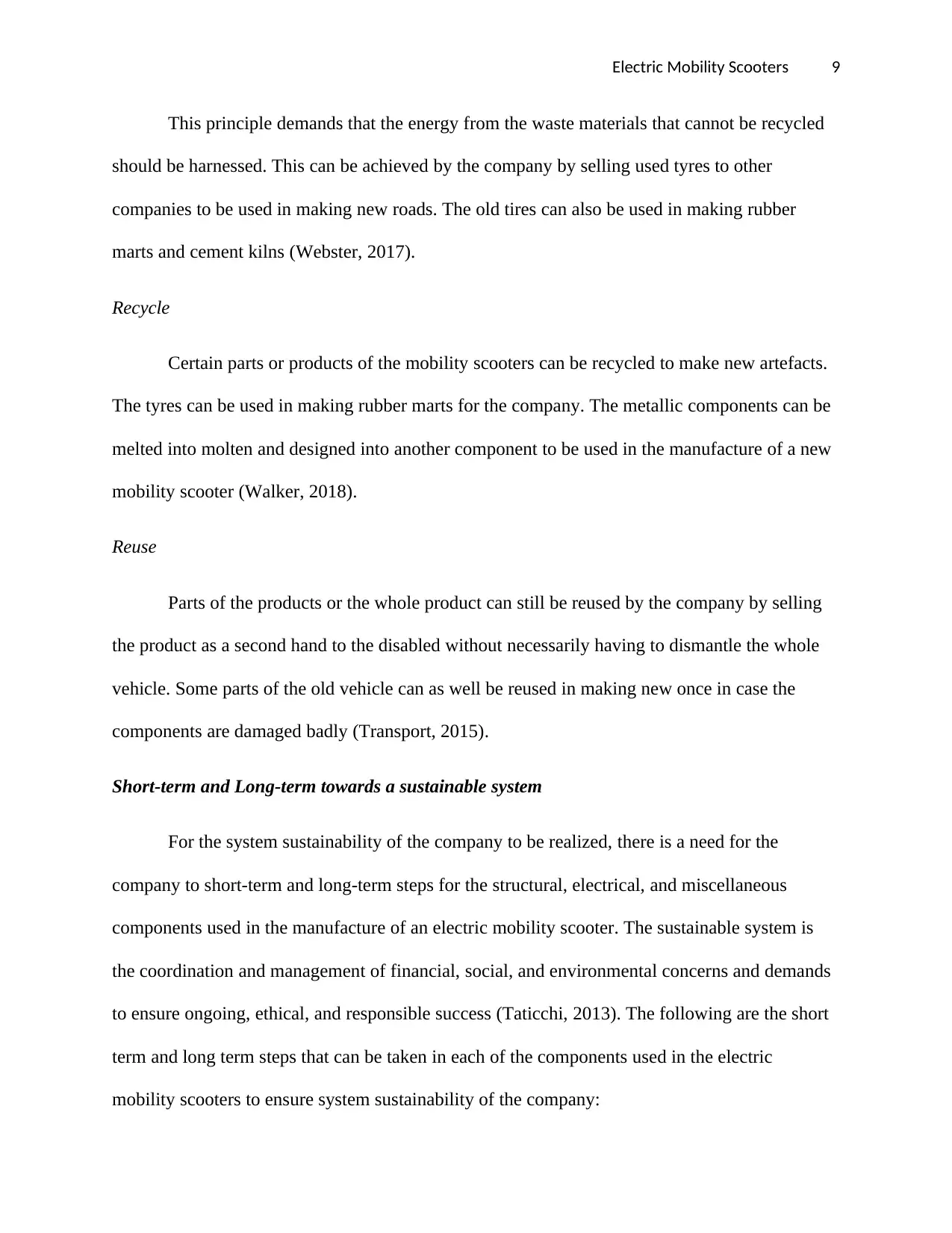
Electric Mobility Scooters 9
This principle demands that the energy from the waste materials that cannot be recycled
should be harnessed. This can be achieved by the company by selling used tyres to other
companies to be used in making new roads. The old tires can also be used in making rubber
marts and cement kilns (Webster, 2017).
Recycle
Certain parts or products of the mobility scooters can be recycled to make new artefacts.
The tyres can be used in making rubber marts for the company. The metallic components can be
melted into molten and designed into another component to be used in the manufacture of a new
mobility scooter (Walker, 2018).
Reuse
Parts of the products or the whole product can still be reused by the company by selling
the product as a second hand to the disabled without necessarily having to dismantle the whole
vehicle. Some parts of the old vehicle can as well be reused in making new once in case the
components are damaged badly (Transport, 2015).
Short-term and Long-term towards a sustainable system
For the system sustainability of the company to be realized, there is a need for the
company to short-term and long-term steps for the structural, electrical, and miscellaneous
components used in the manufacture of an electric mobility scooter. The sustainable system is
the coordination and management of financial, social, and environmental concerns and demands
to ensure ongoing, ethical, and responsible success (Taticchi, 2013). The following are the short
term and long term steps that can be taken in each of the components used in the electric
mobility scooters to ensure system sustainability of the company:
This principle demands that the energy from the waste materials that cannot be recycled
should be harnessed. This can be achieved by the company by selling used tyres to other
companies to be used in making new roads. The old tires can also be used in making rubber
marts and cement kilns (Webster, 2017).
Recycle
Certain parts or products of the mobility scooters can be recycled to make new artefacts.
The tyres can be used in making rubber marts for the company. The metallic components can be
melted into molten and designed into another component to be used in the manufacture of a new
mobility scooter (Walker, 2018).
Reuse
Parts of the products or the whole product can still be reused by the company by selling
the product as a second hand to the disabled without necessarily having to dismantle the whole
vehicle. Some parts of the old vehicle can as well be reused in making new once in case the
components are damaged badly (Transport, 2015).
Short-term and Long-term towards a sustainable system
For the system sustainability of the company to be realized, there is a need for the
company to short-term and long-term steps for the structural, electrical, and miscellaneous
components used in the manufacture of an electric mobility scooter. The sustainable system is
the coordination and management of financial, social, and environmental concerns and demands
to ensure ongoing, ethical, and responsible success (Taticchi, 2013). The following are the short
term and long term steps that can be taken in each of the components used in the electric
mobility scooters to ensure system sustainability of the company:
⊘ This is a preview!⊘
Do you want full access?
Subscribe today to unlock all pages.

Trusted by 1+ million students worldwide
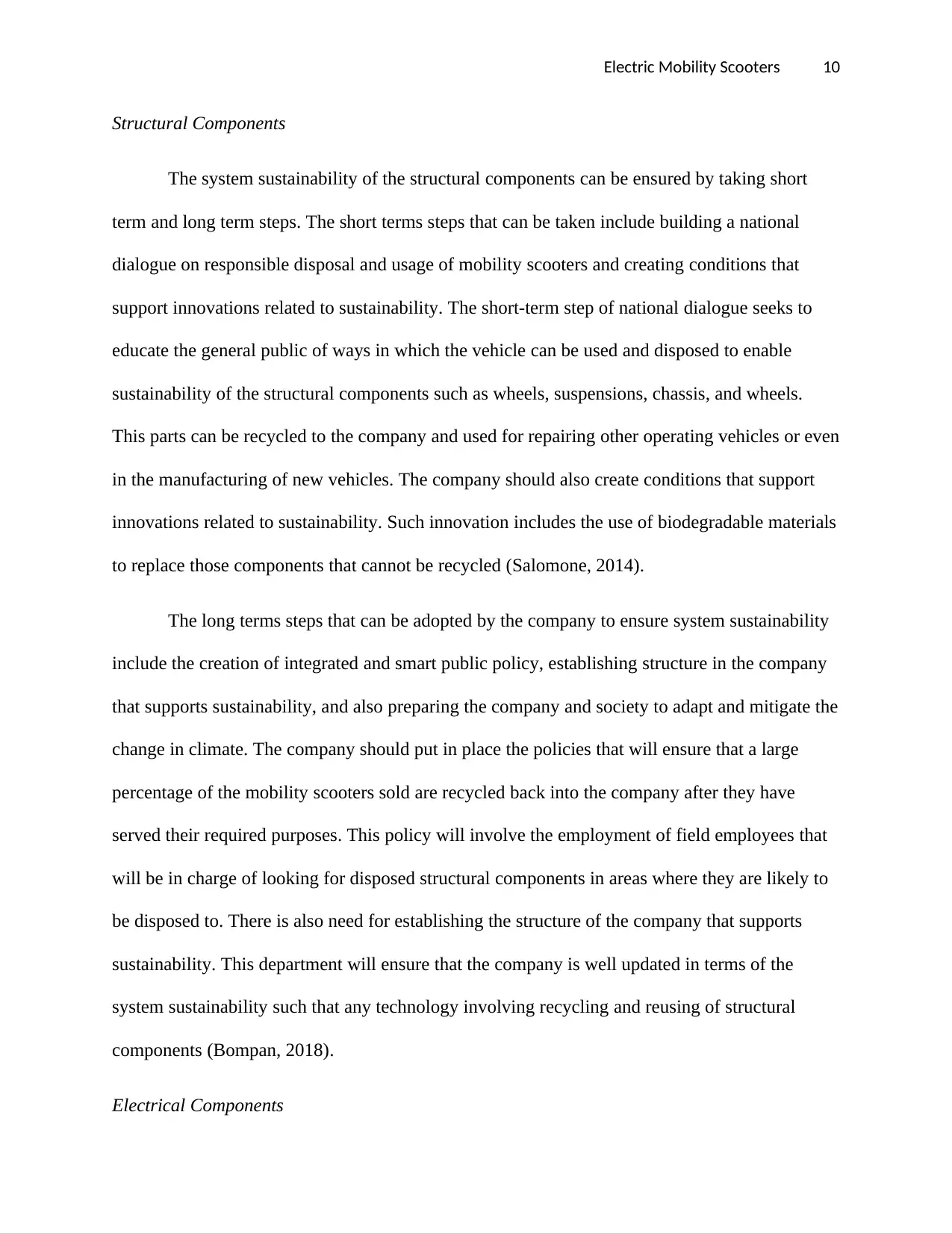
Electric Mobility Scooters 10
Structural Components
The system sustainability of the structural components can be ensured by taking short
term and long term steps. The short terms steps that can be taken include building a national
dialogue on responsible disposal and usage of mobility scooters and creating conditions that
support innovations related to sustainability. The short-term step of national dialogue seeks to
educate the general public of ways in which the vehicle can be used and disposed to enable
sustainability of the structural components such as wheels, suspensions, chassis, and wheels.
This parts can be recycled to the company and used for repairing other operating vehicles or even
in the manufacturing of new vehicles. The company should also create conditions that support
innovations related to sustainability. Such innovation includes the use of biodegradable materials
to replace those components that cannot be recycled (Salomone, 2014).
The long terms steps that can be adopted by the company to ensure system sustainability
include the creation of integrated and smart public policy, establishing structure in the company
that supports sustainability, and also preparing the company and society to adapt and mitigate the
change in climate. The company should put in place the policies that will ensure that a large
percentage of the mobility scooters sold are recycled back into the company after they have
served their required purposes. This policy will involve the employment of field employees that
will be in charge of looking for disposed structural components in areas where they are likely to
be disposed to. There is also need for establishing the structure of the company that supports
sustainability. This department will ensure that the company is well updated in terms of the
system sustainability such that any technology involving recycling and reusing of structural
components (Bompan, 2018).
Electrical Components
Structural Components
The system sustainability of the structural components can be ensured by taking short
term and long term steps. The short terms steps that can be taken include building a national
dialogue on responsible disposal and usage of mobility scooters and creating conditions that
support innovations related to sustainability. The short-term step of national dialogue seeks to
educate the general public of ways in which the vehicle can be used and disposed to enable
sustainability of the structural components such as wheels, suspensions, chassis, and wheels.
This parts can be recycled to the company and used for repairing other operating vehicles or even
in the manufacturing of new vehicles. The company should also create conditions that support
innovations related to sustainability. Such innovation includes the use of biodegradable materials
to replace those components that cannot be recycled (Salomone, 2014).
The long terms steps that can be adopted by the company to ensure system sustainability
include the creation of integrated and smart public policy, establishing structure in the company
that supports sustainability, and also preparing the company and society to adapt and mitigate the
change in climate. The company should put in place the policies that will ensure that a large
percentage of the mobility scooters sold are recycled back into the company after they have
served their required purposes. This policy will involve the employment of field employees that
will be in charge of looking for disposed structural components in areas where they are likely to
be disposed to. There is also need for establishing the structure of the company that supports
sustainability. This department will ensure that the company is well updated in terms of the
system sustainability such that any technology involving recycling and reusing of structural
components (Bompan, 2018).
Electrical Components
Paraphrase This Document
Need a fresh take? Get an instant paraphrase of this document with our AI Paraphraser
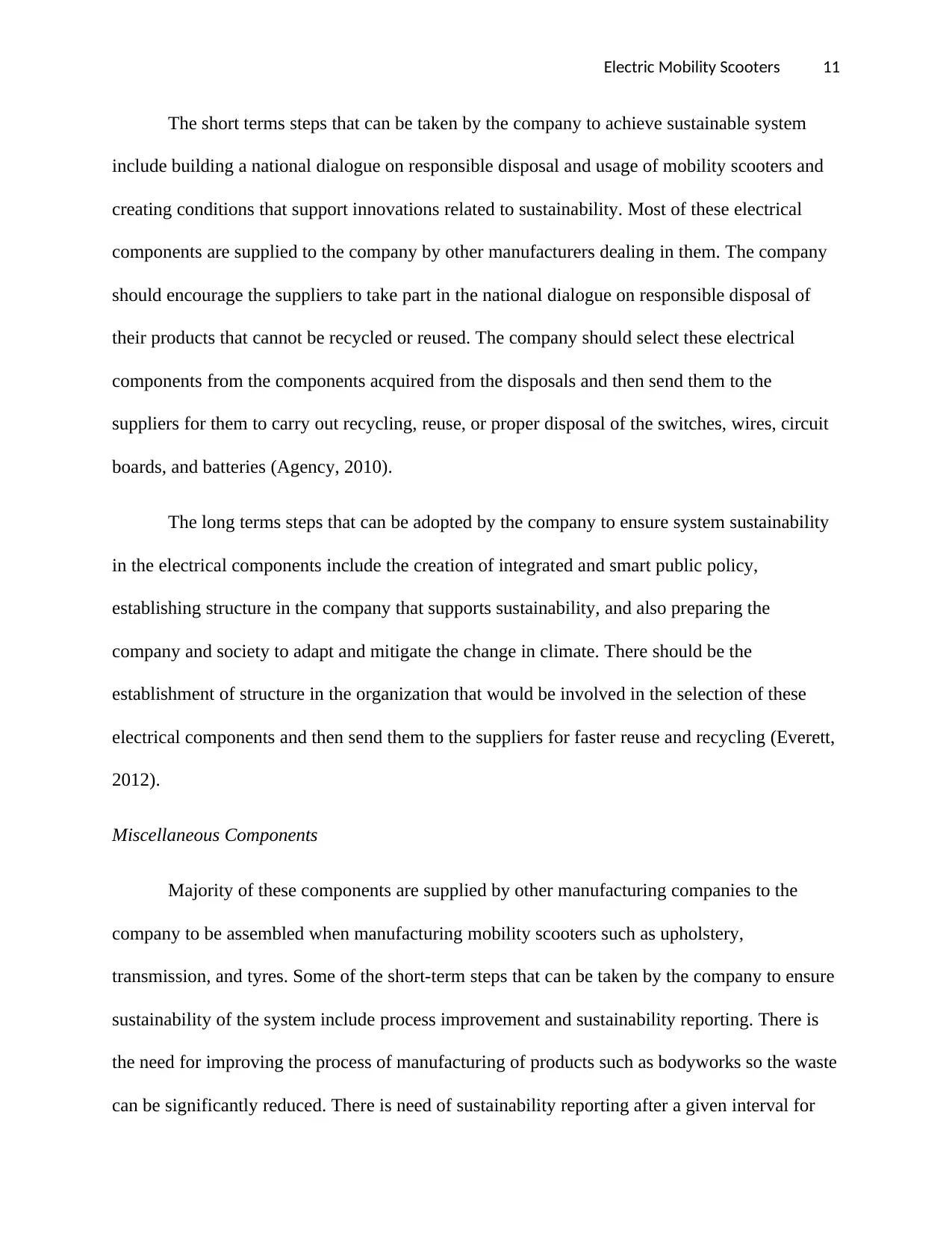
Electric Mobility Scooters 11
The short terms steps that can be taken by the company to achieve sustainable system
include building a national dialogue on responsible disposal and usage of mobility scooters and
creating conditions that support innovations related to sustainability. Most of these electrical
components are supplied to the company by other manufacturers dealing in them. The company
should encourage the suppliers to take part in the national dialogue on responsible disposal of
their products that cannot be recycled or reused. The company should select these electrical
components from the components acquired from the disposals and then send them to the
suppliers for them to carry out recycling, reuse, or proper disposal of the switches, wires, circuit
boards, and batteries (Agency, 2010).
The long terms steps that can be adopted by the company to ensure system sustainability
in the electrical components include the creation of integrated and smart public policy,
establishing structure in the company that supports sustainability, and also preparing the
company and society to adapt and mitigate the change in climate. There should be the
establishment of structure in the organization that would be involved in the selection of these
electrical components and then send them to the suppliers for faster reuse and recycling (Everett,
2012).
Miscellaneous Components
Majority of these components are supplied by other manufacturing companies to the
company to be assembled when manufacturing mobility scooters such as upholstery,
transmission, and tyres. Some of the short-term steps that can be taken by the company to ensure
sustainability of the system include process improvement and sustainability reporting. There is
the need for improving the process of manufacturing of products such as bodyworks so the waste
can be significantly reduced. There is need of sustainability reporting after a given interval for
The short terms steps that can be taken by the company to achieve sustainable system
include building a national dialogue on responsible disposal and usage of mobility scooters and
creating conditions that support innovations related to sustainability. Most of these electrical
components are supplied to the company by other manufacturers dealing in them. The company
should encourage the suppliers to take part in the national dialogue on responsible disposal of
their products that cannot be recycled or reused. The company should select these electrical
components from the components acquired from the disposals and then send them to the
suppliers for them to carry out recycling, reuse, or proper disposal of the switches, wires, circuit
boards, and batteries (Agency, 2010).
The long terms steps that can be adopted by the company to ensure system sustainability
in the electrical components include the creation of integrated and smart public policy,
establishing structure in the company that supports sustainability, and also preparing the
company and society to adapt and mitigate the change in climate. There should be the
establishment of structure in the organization that would be involved in the selection of these
electrical components and then send them to the suppliers for faster reuse and recycling (Everett,
2012).
Miscellaneous Components
Majority of these components are supplied by other manufacturing companies to the
company to be assembled when manufacturing mobility scooters such as upholstery,
transmission, and tyres. Some of the short-term steps that can be taken by the company to ensure
sustainability of the system include process improvement and sustainability reporting. There is
the need for improving the process of manufacturing of products such as bodyworks so the waste
can be significantly reduced. There is need of sustainability reporting after a given interval for
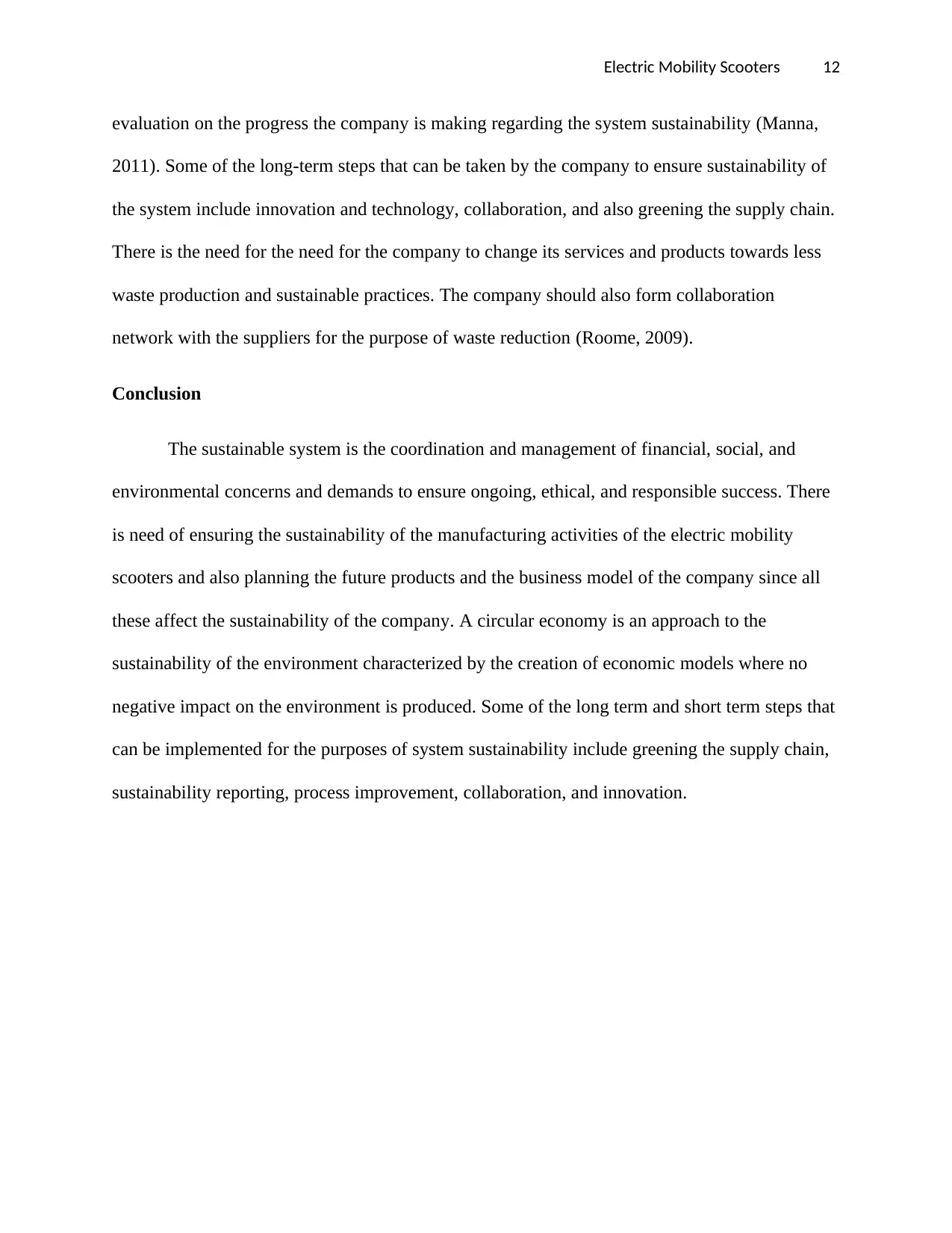
Electric Mobility Scooters 12
evaluation on the progress the company is making regarding the system sustainability (Manna,
2011). Some of the long-term steps that can be taken by the company to ensure sustainability of
the system include innovation and technology, collaboration, and also greening the supply chain.
There is the need for the need for the company to change its services and products towards less
waste production and sustainable practices. The company should also form collaboration
network with the suppliers for the purpose of waste reduction (Roome, 2009).
Conclusion
The sustainable system is the coordination and management of financial, social, and
environmental concerns and demands to ensure ongoing, ethical, and responsible success. There
is need of ensuring the sustainability of the manufacturing activities of the electric mobility
scooters and also planning the future products and the business model of the company since all
these affect the sustainability of the company. A circular economy is an approach to the
sustainability of the environment characterized by the creation of economic models where no
negative impact on the environment is produced. Some of the long term and short term steps that
can be implemented for the purposes of system sustainability include greening the supply chain,
sustainability reporting, process improvement, collaboration, and innovation.
evaluation on the progress the company is making regarding the system sustainability (Manna,
2011). Some of the long-term steps that can be taken by the company to ensure sustainability of
the system include innovation and technology, collaboration, and also greening the supply chain.
There is the need for the need for the company to change its services and products towards less
waste production and sustainable practices. The company should also form collaboration
network with the suppliers for the purpose of waste reduction (Roome, 2009).
Conclusion
The sustainable system is the coordination and management of financial, social, and
environmental concerns and demands to ensure ongoing, ethical, and responsible success. There
is need of ensuring the sustainability of the manufacturing activities of the electric mobility
scooters and also planning the future products and the business model of the company since all
these affect the sustainability of the company. A circular economy is an approach to the
sustainability of the environment characterized by the creation of economic models where no
negative impact on the environment is produced. Some of the long term and short term steps that
can be implemented for the purposes of system sustainability include greening the supply chain,
sustainability reporting, process improvement, collaboration, and innovation.
⊘ This is a preview!⊘
Do you want full access?
Subscribe today to unlock all pages.

Trusted by 1+ million students worldwide
1 out of 16
Related Documents
Your All-in-One AI-Powered Toolkit for Academic Success.
+13062052269
info@desklib.com
Available 24*7 on WhatsApp / Email
![[object Object]](/_next/static/media/star-bottom.7253800d.svg)
Unlock your academic potential
Copyright © 2020–2025 A2Z Services. All Rights Reserved. Developed and managed by ZUCOL.





